
 arrying silk and jade, we set off like the traders of old along the southern rim of the Heavenly Mountains, on the last leg of our journey along the Silk Roads. But we were carrying souvenirs, not merchandise, and we were traveling not by camel but by jet.
arrying silk and jade, we set off like the traders of old along the southern rim of the Heavenly Mountains, on the last leg of our journey along the Silk Roads. But we were carrying souvenirs, not merchandise, and we were traveling not by camel but by jet.
Xinjiang's forbidding no-man's-land between West and East might almost have been designed expressly as a barrier by nature; except by air, it is almost as difficult to cross today as it was in ancient times. To the east are the Lop and Gobi Deserts, to the north, south and west the Tian Shan, Kunlun, Pamir and Karakoram ranges, while the central Tarim Basin is for the most part covered by the shifting sands of the Taklamakan Desert.
Nearly 1,000 kilometers (620 miles) across, east to west, and 400 kilometers (250 miles) from north to south, the Taklamakan's red-gold dunes tower as high as 100 meters (325 feet). Driven by relentless winds, they are said to have buried without trace caravans, armies and towns. And although some of these terrible tales were undoubtedly spread by merchants seeking to deter competition, few travelers have ever had a good word to say about the Taklamakan.
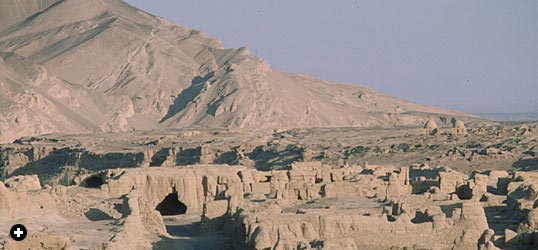 |
| The abandoned Silk Roads citadel of Jiaohe, western China. |
The ancient Chinese believed the desert was inhabited by demons and evil spirits which lured travelers to a thirsty grave; the modern Chinese use it for testing nuclear weapons. Marco Polo wrote of terrifying mirages - "hosts of men coming toward them" - which caused merchants, "suspecting they were robbers," to take flight and lose their way; modern Swedish explorer Sven Hedin called it "the most dangerous desert in the world."
Because there was no safe way across this deadly dustbowl, the Silk Roads, after descending the precipitous defiles of the "roof of the world" to Kashgar, divided around the fringes of the Taklamakan, where the occasional glacier-fed river made human habitation possible.
 |
| An aerial view of the Heavenly Mountains near Ürumqi. |
The route south of the Taklamakan followed the foothills of the Karakoram range to the oasis of Yarkand, where it was joined by a feeder road from India, and continued east along the fringe of the Kunlun Mountains to the ancient jade market of Khotan.
The northern route followed the foothills of the Tian Shan to Kucha before descending into one of the deepest depressions on earth to the surprisingly bountiful oasis of Turpan.
Here, 154 meters (500 feet) below sea level, in ovenlike temperatures of 40 degrees Centigrade (104°F) and watered by a mere 16 millimeters (five-eighths of an inch) of rain a year, a bastion of civilization thrived in which religions and cultures coexisted and literature and art flourished.
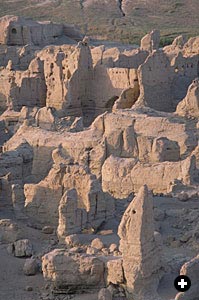 |
| The looted Buddhist cave monastery of Bezeklik. |
Turpan's secret was a network of hand-dug gravity tunnels that carried melted snow from the nearby Tian Shan range. Even today this centuries-old system supports a sizeable city surrounded by fertile farmland that produces grapes and melons prized throughout China, and irrigates verdant stands of elm, poplar and palm that keep the desert at bay.
Located in the ill-defined borderland shared by the nomadic peoples of the north and the settled oasis-dwellers of Xinjiang, Turpan has always been an important center of administration and trade. Here, in the first century BC, Han emperors established the military base of Jiaohe to defend China's borderlands and protect its trade with the West.
Jiaohe was a natural fortress, a citadel built on a small island left between two rivers when melting snows from Tian Shan glaciers gouged out deep ravines. With cliffs 20 to 30 meters high (65 to 100 feet) on either side, Jiaohe did not even need a city wall.
During the Han dynasty 1,000 troops were stationed here, and by the eighth century Jiaohe supported a population of 7,000. But then, as the climate became drier and the river's flow more scant, the citadel was gradually abandoned in favor of the modern city of Turpan, 13 kilometers (eight miles) to the east.
Today Jiaohe still stands, a silent, ghostly warren of adobe walls, nearly perfectly preserved by the very dryness that brought its demise. Close inspection of these seemingly random shapes reveals clearly defined streets and houses laid out in grid fashion: a lifesize model of a city constructed 1,200 years ago.
Another reminder of Turpan's former importance is the ruins of Gaochang, capital of the Uygur kingdom of Khocho, which flourished in Xinjiang from the ninth to the 13th century. This city, which was an important staging post on the Silk Roads, supported a multiracial, multilingual population of 30,000 and was ringed by an imposing wall 12 meters (39 feet) thick and six kilometers (3.7 miles) long, much of which still stands today.
Although Uygur rulers adopted the Manichean religion, and Nestorian Christianity gained a foothold in Turpan, Xinjiang's masses were Buddhist - until, beginning in the 10th century, the entire population converted to Islam.
So complete, in fact, was the eclipse of these pre-Islamic cultures that it was not until the start of this century that their past existence in this remote part of the world was rediscovered. In mountain gorges along the Silk Roads where local Buddhists carved out and decorated cave temples in cliff walls, archeologists discovered magnificent frescoes and libraries. They also found priceless relics of Manichean and Nestorian literature.
These finds spurred a great rush of treasure hunters, who cut from cave walls frescoes that had survived 1,000 years and sent them to "safety" in western Europe and Japan. Many of them perished when the Berlin Ethnological Museum was destroyed by Allied bombing in World War II.
Some of those responsible for these archeological thefts were, like me, British -and the only time I felt myself the object of any animosity during our five weeks in China was when the guardian of the looted cave monastary of Bezeklik, near Turpan, pointed accusingly at the sites of missing frescoes and, scowling, said, "Stolen!"
It took two nights and a day to cross the Gobi desert, traveling in a scheduled Chinese passenger train pulled by a shiny black 133-ton, 2,500-horsepower steam locomotive, its six driving wheels painted bright red and edged with white.
 |
| A silk merchant at Kashgar. |
While the steam locomotive we had used at the start of our journey in Turkey was mainly for historical effect, this one was the equipment regularly used on the route. About 7,000 steam locomotives still ply the rails in China, pulling 70 percent of the country's freight and 60 percent of its passengers - and that means three million people a day.
Soft class - a carpeted corridor car with private sleeping compartments done in white linen - was almost empty. Hard class - bare dormitory carriages - was packed to overflowing. But the Chinese, untroubled by the lack of privacy, were making a party of it, playing cards, sharing food and swapping stories. I swapped a copy of Aramco World for a battered edition of the comic-strip adventures of the Belgian boy reporter Tintin - in Chinese.
Sometime during the second night we slipped past Anxi, where the Silk Roads north and south of the Taklamakan rejoined to course eastward through the Yumen Pass, or Jade Gate, and past the western end of the 2,400-kilometer (1,500-mile) Great Wall into China proper.
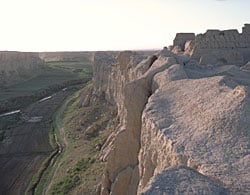 |
Once inside the protection of the Great Wall the going was fairly easy: A paved road, the Imperial Highway, followed the 1,200-kilometer (740-mile) Gansu Corridor, then and now a natural link between China's western borderlands and the Yellow River (Huang Ho) valley, birthplace of Chinese civilization.
It was along the Yellow River in north-central China that, according to historians, neolithic farmers first discovered sericulture - the art of rearing silkworms for thread - about 4,000 years ago.
The legend that credits Xiling, the wife of Emperor Huangdi,with first unraveling the mile or so of thread from a silkworm's cocoon, places that event 4,650 years ago.
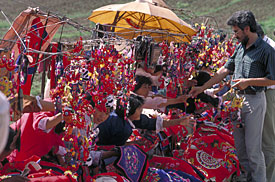 |
| Souvenir sellers near Xian. |
And archeologists claim - on the basis of silk fabrics found in 1958 in the Tai Lake region of western China - that the history of China's silk industry goes back further still, perhaps as far as 5,000 years ago.
Whatever the case, silk has been an important part of China's economy and culture for as long as anyone can remember - and remains so still. Early Chinese temples honoring the spirits of earth and sky were hung with shining silk banners; fine silk clothes and furnishings marked special occasions in life in ancient China and were often interred with the dead.
By the time of the Han dynasty, silk weaving had become an important industry and its products one of China's chief exports: Silk was used by Han rulers as diplomatic gifts and to buy off the troublesome nomads of the north. Silk was a symbol of royalty, wealth and power.
 |
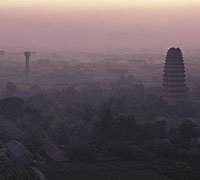 |
| Xian, eastern terminus of the Silk Roads. |
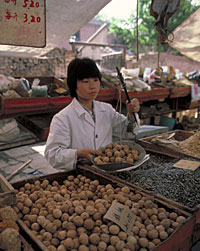 |
| Walnuts on sale in Xian. |
So important was silk that the process of making it was guarded in ancient China as carefully as nations today guard their atomic secrets. Exporting the eggs of the silkworm or the seeds of the mulberry tree was punishable by death, and visiting foreigners were kept away from silkworm nurseries and mulberry-tree plantations.
Because of this, sericulture remained a mystery to the West for centuries - the Romans believed that silk came from the bark of a tree. Eventually, however, the secret leaked out. One famous fable recounts that a Chinese princess, married off to the King of Khotan, smuggled silkworms hidden in her hair past Chinese frontier guards. British archeologist Sir Aurel Stein found a fresco depicting this princess near Khotan - implying that the woman who betrayed China's best-kept secret was a heroine to the Khotanese - and documents unearthed at Turpan confirm that sericulture existed there in the fifth century. By the sixth century the techniques of silk weaving had spread to Persia, and the secret of sericulture had been smuggled to Byzantium.
But despite its production in several countries today, and despite competition from man-made fibers, Chinese silk is still prized throughout the world, and remains one of the country's most prestigious exports: 9,300 tons of natural silk, 70,000,000 meters (75,000,000 yards) of silk garments and 150,000,000 meters (162,500,000 yards) of unsewn silk cloth are sold abroad each year. The cloth alone would reach four times around the earth - or more than 15 times the entire length of our journey along the Silk Roads, from Turkey to China.
China itself is not immune to the mystique of the Silk Roads. At Lanzhou, a former staging post on the Yellow River, we watched the Song and Dance Ensemble of Gansu Province rehearsing a popular ballet entitled "Tales of the Silk Road." It is based on stories told in 45,000 square meters (11 acres) of paintings on the walls of 492 caves carved out of a cliff face at Dunhuang, once an important Buddhist center southwest of Anxi. The caves were decorated by monks between the fourth and 14th centuries.
Still in Lanzhou, by contrast, we slept in the Communist Party guest house - more comfortable than most hotels in China - and, in the dining room of a state-run oil refinery, had a buffet lunch that outclassed any I had experienced during press tours of factories in the West. In fact, the food in China was by far the best on our journey.
Back on the train, we made the final run to Xian across the green-and-yellow Shaanxi plain, where farmers in lampshade hats stack their wheat in sheaves covered with straw "hats" of the same shape to protect them from the rain. Formerly Ch'ang-an, "City of Eternal Peace" and capital of 11 dynasties, Xian was the eastern terminus of the Silk Roads for 1,100 years.
Once one of the most important cities in the world, Xian's population in the seventh century topped two million, including large communities of foreign traders - among them Muslims who built China's biggest mosque. Today, Xian's Muslim citizens, some of them descendants of traders on the Silk Roads, still pray in that mosque, and their restaurants and shops add flavor to the city.
Our train skirted the rectangular city wall of Xian - 14 kilometers (nine miles) long and, in the city's great days, wide enough to allow two-way chariot traffic along its top - then cut through a breach to the central station. Once China's entry point for new ideas and new technology, Xian today is experiencing a revival as thousands of foreigners once more beat a track through its imposing city gates, following the discovery nearby of the life-size, 6,000-man terra-cotta army buried 2,200 years ago to guard the tomb of Emperor Qin Shi Huangdi, the first unifier of China.
Recent reforms have allowed private economic enterprise to flourish in China, and in Xian's bustling Free Market we treated ourselves to an appropriate end-of-journey souvenir: a bag of walnuts grown in China from nuts or seedlings carried along the Silk Roads from the West.
Suddenly our travels were over - and everything I had been fighting off for the past few weeks - cold, damp and germs -caught up with me. As I lay recuperating in a darkened hotel room in Hong Kong, I recalled Marco Polo's deathbed assertion to those who insisted he retract his unbelievable and apparently fantastic stories of far-off lands.
He replied, "I have not told half of what I saw."
And neither have I.
< Previous Story





